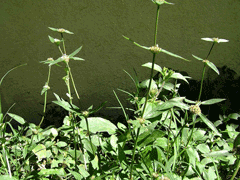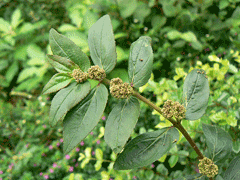 |
|
http://commons.wikimedia.org/wiki/User:Tau%CA%BBolunga |
 |
| http://flickr.com/photos/91314344%40N00/ |
Translate this page:
Summary
Physical Characteristics

 Euphorbia hirta is a ANNUAL growing to 0.3 m (1ft) by 0.3 m (1ft in).
Euphorbia hirta is a ANNUAL growing to 0.3 m (1ft) by 0.3 m (1ft in).
It is frost tender. The species is monoecious (individual flowers are either male or female, but both sexes can be found on the same plant) and is pollinated by Insects.
Suitable for: light (sandy) and medium (loamy) soils and prefers well-drained soil. Suitable pH: mildly acid, neutral and basic (mildly alkaline) soils. It cannot grow in the shade. It prefers dry or moist soil.
UK Hardiness Map
US Hardiness Map
Synonyms
Chamaesyce gemella. Chamaesyce karwinskyi. Desmonema hirta. Ditritea hirta. Euphorbia chrysochaeta
Plant Habitats
Cultivated Beds;
Edible Uses
Edible Parts: Leaves Shoots
Edible Uses:
Tender young leaves and shoots - cooked as a vegetable[272]. A famine food, used when all else fails[177, 179] and I would have to be very desperate to eat it even then[K].
References More on Edible Uses
Medicinal Uses
Plants For A Future can not take any responsibility for any adverse effects from the use of plants. Always seek advice from a professional before using a plant medicinally.
Anodyne Antiasthmatic Antipruritic Carminative Depurative Diuretic Dysentery Febrifuge
Galactogogue Purgative VD Vermifuge Warts
Asthma weed has traditionally been used in Asia to treat bronchitic asthma and laryngeal spasm, though in modern herbalism it is more used in the treatment of intestinal amoebic dysentery[268]. It should not be used without expert guidance, however, since large doses cause gastro-intestinal irritation, nausea and vomiting[268]. The plant is anodyne, antipruritic, carminative, depurative, diuretic, febrifuge, galactogogue, purgative and vermifuge[218].The aerial parts of the plant are harvested when in flower during the summer and can be dried for later use[238]. The stem, taken internally, is famed as a treatment for asthma, bronchitis and various other lung complaints[218, 238, 240]. The herb relaxes the bronchioles but apparently depresses the heart and general respiration[218]. It is usually used in combination with other anti-asthma herbs such as Grindelia camporum and Lobelia inflata[254]. It is also used to treat intestinal amoebic dysentery[254]. The whole plant is decocted and used in the treatment of athlete's foot, dysentery, enteritis and skin conditions[218]. It has been used in the treatment of syphilis[4]. The sap is applied to warts in order to destroy them[238, 240]. The treatment needs to be repeated 2 - 3 times a day over a period of several weeks to be fully effective[K].
References More on Medicinal Uses
The Bookshop: Edible Plant Books
Our Latest books on Perennial Plants For Food Forests and Permaculture Gardens in paperback or digital formats.

Edible Tropical Plants
Food Forest Plants for Hotter Conditions: 250+ Plants For Tropical Food Forests & Permaculture Gardens.
More

Edible Temperate Plants
Plants for Your Food Forest: 500 Plants for Temperate Food Forests & Permaculture Gardens.
More

More Books
PFAF have eight books available in paperback and digital formats. Browse the shop for more information.
Shop Now
Other Uses
References More on Other Uses
Cultivation details
Prefers a light well-drained moderately rich loam in an open sunny position[200]. The plant is not very tolerant of frost[238], though it can probably be grown successfully in this country as a spring-sown annual[K]. Hybridizes with other members of this genus[200]. The ripe seed is released explosively from the seed capsules[200]. Members of this genus are rarely if ever troubled by browsing deer or rabbits[233]. This genus has been singled out as a potential source of latex (for making rubber) for the temperate zone, although no individual species has been singled out[141].
References Carbon Farming Information and Carbon Sequestration Information
Temperature Converter
Type a value in the Celsius field to convert the value to Fahrenheit:
Fahrenheit:
The PFAF Bookshop
Plants For A Future have a number of books available in paperback and digital form. Book titles include Edible Plants, Edible Perennials, Edible Trees,Edible Shrubs, Woodland Gardening, and Temperate Food Forest Plants. Our new book is Food Forest Plants For Hotter Conditions (Tropical and Sub-Tropical).
Shop Now
Plant Propagation
Seed - sow mid to late spring in situ. Germination usually takes place within 2 - 3 weeks at 20°c. It might be best to sow the seed in a cool greenhouse in early March. When they are large enough to handle, prick the seedlings out into individual pots and plant out the seedlings in late May. This will give the plants longer to grow and mature.
Other Names
If available other names are mentioned here
Native Range
NORTHERN AMERICA: United States (Alabama, Florida, Georgia, Louisiana, South Carolina, New Mexico, Texas, Arizona), Mexico (Chihuahua, Durango, Nuevo León, San Luis Potosí, Sinaloa, Sonora, Tamaulipas, Zacatecas, Campeche, Chiapas, Colima, Guanajuato, Guerrero, Hidalgo, Jalisco, México, Michoacán de Ocampo, Morelos, Nayarit, Oaxaca, Puebla, Querétaro, Quintana Roo, Tabasco, Veracruz de Ignacio de la Llave, Yucatán) SOUTHERN AMERICA: Antigua and Barbuda, Barbados, Dominica, Guadeloupe, Grenada, St. Kitts and Nevis, St. Lucia, Montserrat, Martinique, Trinidad and Tobago, St. Vincent and Grenadines, Belize, Costa Rica, Guatemala, Honduras, Nicaragua, Panama, El Salvador, French Guiana, Guyana, Suriname, Venezuela, Brazil, Bolivia, Colombia, Ecuador, Peru, Argentina, Chile, Paraguay
Weed Potential
Right plant wrong place. We are currently updating this section.
Please note that a plant may be invasive in one area but may not in your area so it's worth checking.
Conservation Status
IUCN Red List of Threatened Plants Status :

| Related Plants
|
| Latin Name | Common Name | Habit | Height | Hardiness | Growth | Soil | Shade | Moisture | Edible | Medicinal | Other |
| Acalypha australis | Asian copperleaf | Annual | 0.5 |
0-0
| | LMH | SN | M | 0 | 1 | |
| Alchornea castaneifolia | Iporuru | Tree | 8.0 |
10-12
| F | LMH | SN | MWe | 0 | 4 | 2 |
| Alchornea cordifolia | Christmas Bush | Shrub | 8.0 |
10-12
| M | LMH | N | DMWe | 2 | 4 | 3 |
| Aleurites cordata | Japan Wood-Oil Tree | Tree | 7.0 |
9-11
| | LM | SN | M | 0 | 0 | 2 |
| Aleurites fordii | Tung Tree, Tung Oil Tree, Wood Oil Tree China | Tree | 7.0 |
8-10
| F | LM | SN | M | 1 | 3 | 3 |
| Aleurites moluccanus | Candle Nut, Country Walnut | Tree | 20.0 |
10-12
| F | LMH | N | DM | 3 | 3 | 4 |
| Caryodendron orinocense | Taccy Nut, Nuez de Barinas | Tree | 25.0 |
10-12
| F | LMH | N | M | 3 | 1 | 2 |
| Chrozophora tinctoria | Dyer's Croton, Giradol | Perennial | 0.0 |
0-0
| | LMH | SN | M | 1 | 0 | 2 |
| Cnidoscolus aconitifolius | Tree Spinach, Tread Softly, Cabbage Star, Chaya | Shrub | 5.0 |
9-11
| F | LMH | SN | M | 4 | 3 | 3 |
| Cnidoscolus elasticus | Highland chilte | Shrub | 1.0 |
9-11
| F | LMH | N | DM | 0 | 0 | 4 |
| Croton lechleri | Sangre De Grado, Dragon's blood | Tree | 12.0 |
10-12
| F | LMH | N | M | 0 | 4 | 1 |
| Croton megalocarpus | Croton tree | Tree | 25.0 |
10-12
| F | LM | N | M | 0 | 2 | 4 |
| Croton palanostigma | Sangre De Grado, Dragon's blood | Tree | 12.0 |
10-12
| F | LM | N | M | 0 | 4 | 2 |
| Croton salutaris | Sangre De Grado, Dragon's blood | Tree | 12.0 |
10-12
| F | LM | N | M | 0 | 4 | 0 |
| Croton tiglium | Croton Oil Plant. Croton, Purging croton. | Tree | 7.0 |
10-12
| M | LMH | N | DM | 0 | 3 | 2 |
| Euphorbia abyssinica | Candelabra Spurge | Tree | 7.5 |
10-12
| M | LM | SN | D | 0 | 2 | 3 |
| Euphorbia antisyphilitica | Candelilla | Shrub | 1.0 |
7-10
| | LM | N | DM | 2 | 0 | 4 |
| Euphorbia corollata | Wild Spurge, Flowering spurge | Perennial | 1.0 |
4-8
| | LM | SN | DM | 0 | 2 | 2 |
| Euphorbia drummondii | Caustic Weed | Annual | 0.2 |
-
| | LM | N | DM | 0 | 1 | |
| Euphorbia esula | Leafy Spurge. Green spurge | Perennial | 1.0 |
3-9
| F | LMH | SN | DM | 0 | 0 | 4 |
| Euphorbia helioscopia | Madwoman's Milk | Annual | 0.4 |
-
| | LM | N | DM | 1 | 2 | |
| Euphorbia humifusa | | Annual | 0.2 |
-
| | LM | N | DM | 1 | 2 | |
| Euphorbia intisy | Intisy, Pencil Plant | Shrub | 5.0 |
10-12
| F | LM | SN | D | 0 | 0 | 3 |
| Euphorbia ipecacuanhae | American Ipec | | 0.0 |
-
| | LMH | SN | M | 0 | 1 | |
| Euphorbia lactea | Mottled Spurge | Shrub | 5.0 |
10-11
| M | LMH | SN | DM | 0 | 0 | 4 |
| Euphorbia lathyris | Caper Spurge, Moleplant | Annual/Biennial | 1.0 |
5-9
| | LMH | SN | DM | 1 | 2 | 3 |
| Euphorbia marginata | Mountain Snow, Ghost Spurge, Ghost Weed | Annual | 0.6 |
4-8
| F | LM | N | DM | 1 | 1 | 3 |
| Euphorbia neriifolia | Fleshy spurge, Hedge Euphorbia, Oleander spurge | Shrub | 4.0 |
10-12
| F | LM | SN | D | 2 | 2 | 2 |
| Euphorbia pekinensis | Da Ji | Perennial | 0.6 |
-
| | LM | N | DM | 0 | 3 | |
|
|
Growth: S = slow M = medium F = fast. Soil: L = light (sandy) M = medium H = heavy (clay). pH: A = acid N = neutral B = basic (alkaline). Shade: F = full shade S = semi-shade N = no shade. Moisture: D = dry M = Moist We = wet Wa = water.
Now available:
Food Forest Plants for Mediterranean Conditions
350+ Perennial Plants For Mediterranean and Drier Food Forests and Permaculture Gardens.
[Paperback and eBook]
This is the third in Plants For A Future's series of plant guides for food forests tailored to
specific climate zones. Following volumes on temperate and tropical ecosystems, this book focuses
on species suited to Mediterranean conditions—regions with hot, dry summers and cool, wet winters,
often facing the added challenge of climate change.
Read More
Expert comment
Author
L.
Botanical References
58
Links / References
For a list of references used on this page please go here
Readers comment